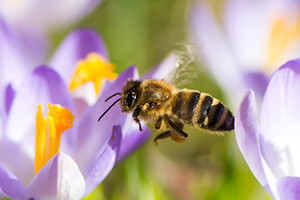
As a semi-retired professional animal nutritionist having worked with a large variety of animal species, my approach to honey bee nutrition is likely somewhat different than those trained in entomology. I have had the opportunity over many years to work with a wide variety of ingredients, many of which are best suited for specific needs for a variety of species. The biggest challenges for honey bee nutrition are the need for more and better information regarding what nutrients the honey bees need, and to be able to manufacture a blend of ingredients that can be reduced to pollen-size that the bees will readily consume, digest and utilize for optimal body functions. Many ingredients may provide appropriate nutrients, but usually not the amounts needed, so it takes a variety of ingredients to provide all of the nutrients in the correct amounts that honey bees need.
Honey bees, like all other animals, require water, protein, fats, carbohydrates, vitamins and minerals.
Water should come from a clean source. Bees seem to like swimming pools, ponds and sometimes “non-hygienic” water sources. I have to wonder if some of this may be related to the taste of the water. It would be like comparing bottled water to water that you have added a flavoring to. Which do you prefer to drink?
Proteins must come primarily from pollens that must be broken down to amino acids, the building blocks of protein, by the bee’s digestive enzymes. Once the proteins are broken down to amino acids, the bee (and all other species) will re-assemble these amino acids into specific proteins and enzymes needed for all body functions. Pollens from various floral sources will vary from 4% protein to 60% protein, while the summer protein needs of the honey bee are in the range of 18-22% protein. This is why bees need to harvest pollens from a variety of plant sources.
Fats (more correctly called lipids) come from pollens, and to a lesser extent nectars, that must be broken down to fatty acids, the building blocks of lipids/fats. While some short-chain fatty acids may be used for energy, the longer chain fatty acids are incorporated into the bee’s cell walls to help maintain cellular structure and function. Very long-chain fatty acids may also be used by the bee to make pheromones and reproductive hormones.
Carbohydrates, which may come from a wide variety of sugars and starches, are used primarily for energy for flight and in-hive activity, and for making honey and bee bread. Some carbohydrates are also used to provide food for the bacteria that ferment the stored pollen and convert it into bee bread for later food use. Nectars are the primary source of simple sugars (glucose and fructose), and the sugar content will vary among the various plant species from 5% to 75%. Bees prefer those floral sources with the higher (sweetest tasting) sugar content. Bees have a limited ability to digest raw starches as commonly found in raw grains, but appear to be able to better digest cooked starches. Uncooked starches are more likely digested by the intestinal bacteria than by the honey bee itself, and too much raw starches in the diet will result in loose feces and diarrhea in many species.
While the role of most vitamins and minerals have not been clearly demonstrated in scientific research, I believe that it is safe to assume that vitamins and minerals play the same basic biochemical role in bees as in other species. The one major exception to this is Vitamin D and its role in the skeleton in vertebrates. Vertebrates (those animals with a spinal column) utilize minerals, especially calcium, phosphorus and magnesium deposited into a protein matrix to form a hard internal skeleton. In these animals, Vitamin D plays a significant role in regulating the deposition of calcium into the skeletal matrix.
Insects, on the other hand, have a hard external skeleton rather than an internal skeleton. This is called an exoskeleton and is chitin-based. Chitin is a sugar-based compound, and is somewhat similar to …


